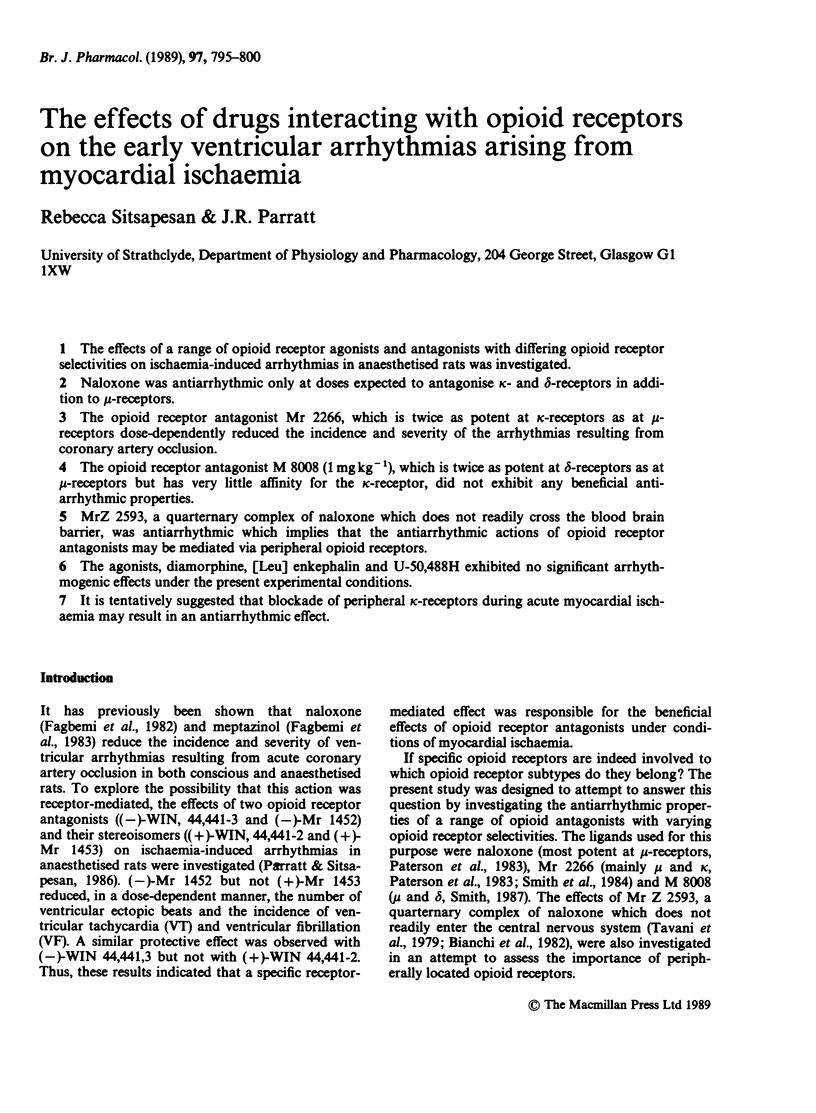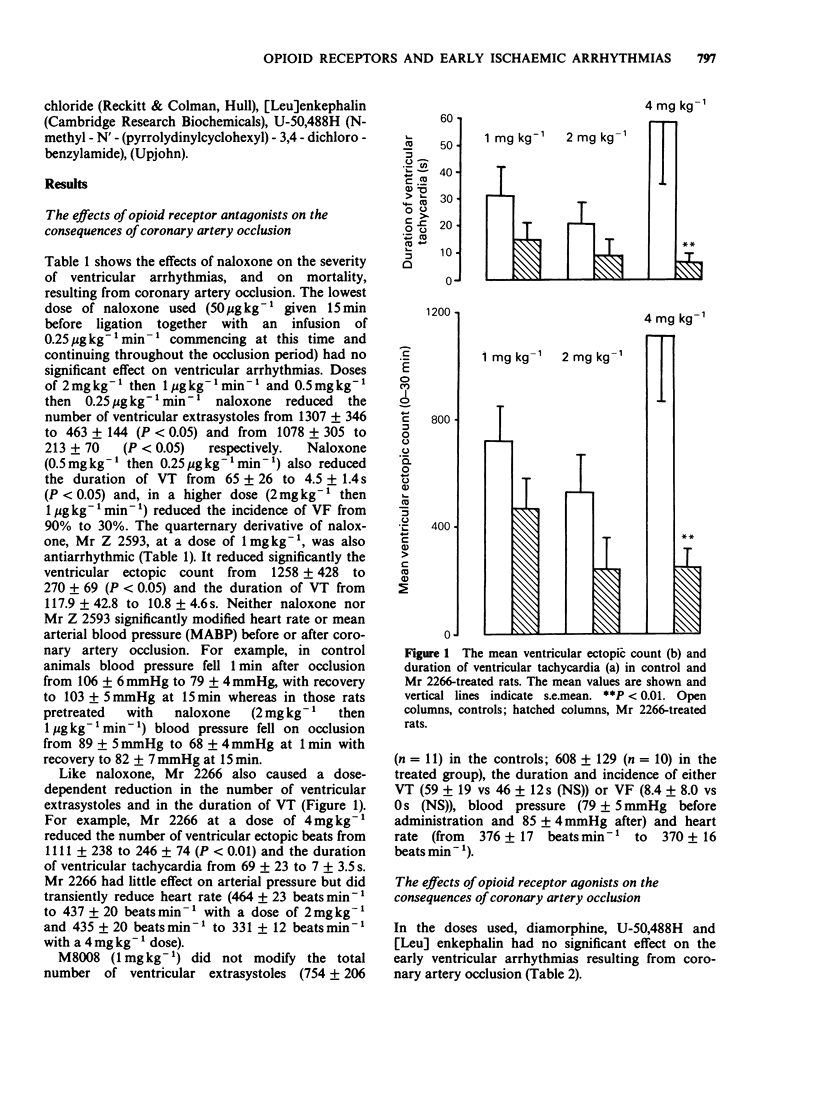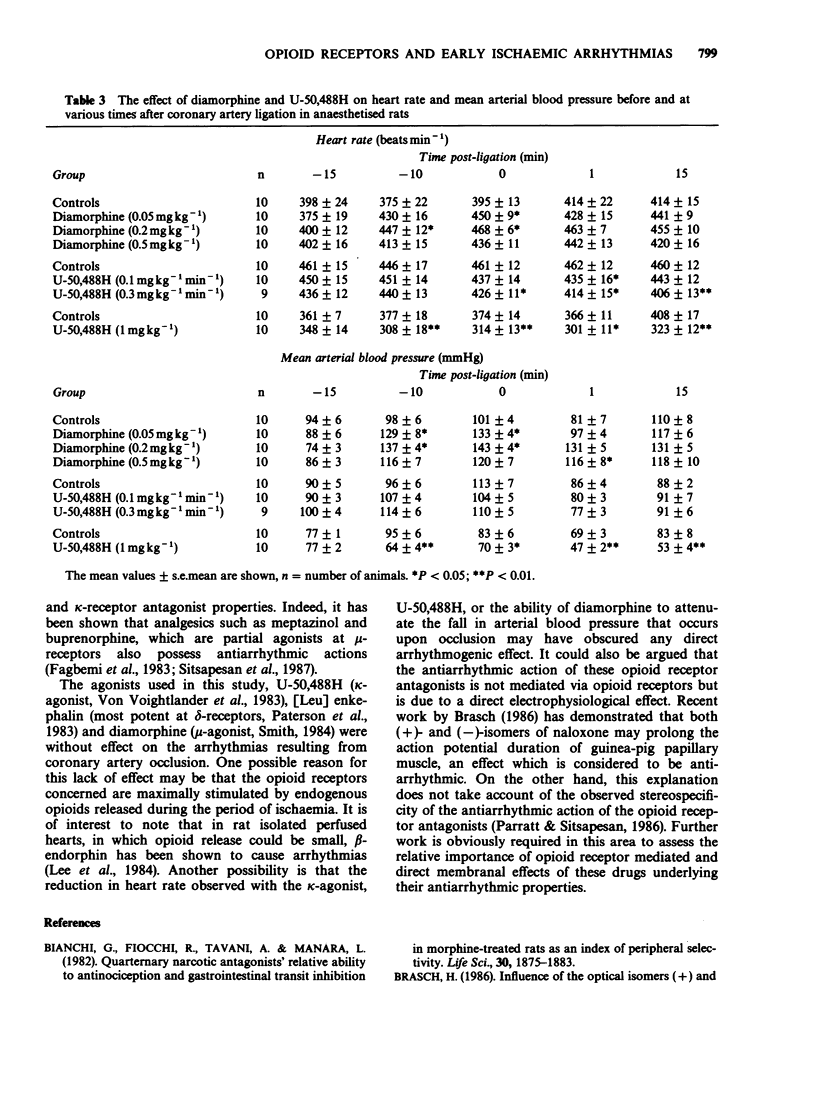Abstract
1. The effects of a range of opioid receptor agonists and antagonists with differing opioid receptor selectivities on ischaemia-induced arrhythmias in anaesthetised rats was investigated. 2. Naloxone was antiarrhythmic only at doses expected to antagonise kappa- and delta-receptors in addition to mu-receptors. 3. The opioid receptor antagonist Mr 2266, which is twice as potent at kappa-receptors as at mu-receptors dose-dependently reduced the incidence and severity of the arrhythmias resulting from coronary artery occlusion. 4. The opioid receptor antagonist M 8008 (1 mg kg-1), which is twice as potent at delta-receptors as at mu-receptors but has very little affinity for the kappa-receptor, did not exhibit any beneficial antiarrhythmic properties. 5. MrZ 2593, a quarternary complex of naloxone which does not readily cross the blood brain barrier, was antiarrhythmic which implies that the antiarrhythmic actions of opioid receptor antagonists may be mediated via peripheral opioid receptors. 6. The agonists, diamorphine, [Leu] enkephalin and U-50,488H exhibited no significant arrhythmogenic effects under the present experimental conditions. 7. It is tentatively suggested that blockade of peripheral kappa-receptors during acute myocardial ischaemia may result in an antiarrhythmic effect.
Full text
PDF





Selected References
These references are in PubMed. This may not be the complete list of references from this article.
- Bianchi G., Fiocchi R., Tavani A., Manara L. Quaternary narcotic antagonists' relative ability to prevent antinociception and gastrointestinal transit inhibition in morphine-treated rats as an index of peripheral selectivity. Life Sci. 1982 May 31;30(22):1875–1883. doi: 10.1016/0024-3205(82)90467-2. [DOI] [PubMed] [Google Scholar]
- Boura A. L., Hodgson W. C., King R. G. Changes in cardiovascular sensitivity of alloxan-treated diabetic rats to arachidonic acid. Br J Pharmacol. 1986 Nov;89(3):613–618. doi: 10.1111/j.1476-5381.1986.tb11163.x. [DOI] [PMC free article] [PubMed] [Google Scholar]
- Brasch H. Influence of the optical isomers (+)- and (-)-naloxone on beating frequency, contractile force and action potentials of guinea-pig isolated cardiac preparations. Br J Pharmacol. 1986 Aug;88(4):733–740. doi: 10.1111/j.1476-5381.1986.tb16245.x. [DOI] [PMC free article] [PubMed] [Google Scholar]
- Clark C., Foreman M. I., Kane K. A., McDonald F. M., Parratt J. R. Coronary artery ligation in anesthetized rats as a method for the production of experimental dysrhythmias and for the determination of infarct size. J Pharmacol Methods. 1980 Jun;3(4):357–368. doi: 10.1016/0160-5402(80)90077-7. [DOI] [PubMed] [Google Scholar]
- Fagbemi O., Kane K. A., Leprán I., Parratt J. R., Szekeres L. Antiarrhythmic actions of meptazinol, a partial agonist at opiate receptors, in acute myocardial ischaemia. Br J Pharmacol. 1983 Mar;78(3):455–460. doi: 10.1111/j.1476-5381.1983.tb08805.x. [DOI] [PMC free article] [PubMed] [Google Scholar]
- Fagbemi O., Leprán I., Parratt J. R., Szekeres L. Naloxone inhibits early arrhythmias resulting from acute coronary ligation. Br J Pharmacol. 1982 Aug;76(4):504–506. doi: 10.1111/j.1476-5381.1982.tb09246.x. [DOI] [PMC free article] [PubMed] [Google Scholar]
- Leander J. D. A kappa opioid effect: increased urination in the rat. J Pharmacol Exp Ther. 1983 Jan;224(1):89–94. [PubMed] [Google Scholar]
- Lee A. Y., Zhan C. Y., Wong T. M. Effects of beta-endorphin on the contraction and electrical activity of the isolated perfused rat heart. Int J Pept Protein Res. 1984 Nov;24(5):525–528. doi: 10.1111/j.1399-3011.1984.tb03154.x. [DOI] [PubMed] [Google Scholar]
- Lord J. A., Waterfield A. A., Hughes J., Kosterlitz H. W. Endogenous opioid peptides: multiple agonists and receptors. Nature. 1977 Jun 9;267(5611):495–499. doi: 10.1038/267495a0. [DOI] [PubMed] [Google Scholar]
- Parratt J. R., Sitsapesan R. Stereospecific antiarrhythmic effect of opioid receptor antagonists in myocardial ischaemia. Br J Pharmacol. 1986 Apr;87(4):621–622. doi: 10.1111/j.1476-5381.1986.tb14577.x. [DOI] [PMC free article] [PubMed] [Google Scholar]
- Paterson S. J., Robson L. E., Kosterlitz H. W. Classification of opioid receptors. Br Med Bull. 1983 Jan;39(1):31–36. doi: 10.1093/oxfordjournals.bmb.a071787. [DOI] [PubMed] [Google Scholar]
- Smith C. B., Bennett-Kelly L., Woods J. H. Comparison of "selective" opiate receptor antagonists on the isolated mouse vas deferens. Neuropeptides. 1984 Dec;5(1-3):161–164. doi: 10.1016/0143-4179(84)90052-0. [DOI] [PubMed] [Google Scholar]
- Smith C. F. 16-Me cyprenorphine (RX 8008M): a potent opioid antagonist with some delta selectivity. Life Sci. 1987 Jan 19;40(3):267–274. doi: 10.1016/0024-3205(87)90342-0. [DOI] [PubMed] [Google Scholar]
- Smith C. F. Morphine, but not diacetyl morphine (heroin), possess opiate antagonist activity in the mouse vas deferens. Neuropeptides. 1984 Dec;5(1-3):173–176. doi: 10.1016/0143-4179(84)90055-6. [DOI] [PubMed] [Google Scholar]
- Tavani A., Bianchi G., Manara L. Morphine no longer blocks gastrointestinal transit but retains antinociceptive action in diallylnormorphine-pretreated rats. Eur J Pharmacol. 1979 Oct 26;59(1-2):151–154. doi: 10.1016/0014-2999(79)90039-6. [DOI] [PubMed] [Google Scholar]
- Vonvoigtlander P. F., Lahti R. A., Ludens J. H. U-50,488: a selective and structurally novel non-Mu (kappa) opioid agonist. J Pharmacol Exp Ther. 1983 Jan;224(1):7–12. [PubMed] [Google Scholar]
- Ward S. J., Pierson A. K., Michne W. F. Multiple opioid receptor profile in vitro and activity in vivo of the potent opioid antagonist Win 44,441-3. Life Sci. 1983;33 (Suppl 1):303–306. doi: 10.1016/0024-3205(83)90503-9. [DOI] [PubMed] [Google Scholar]
- Zhan Z. Y., Lee A. Y., Wong T. M. Naloxone blocks the cardiac effects of myocardial ischaemia and reperfusion in the rat isolated heart. Clin Exp Pharmacol Physiol. 1985 Jul-Aug;12(4):373–378. doi: 10.1111/j.1440-1681.1985.tb00885.x. [DOI] [PubMed] [Google Scholar]


